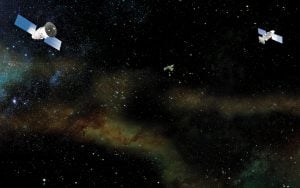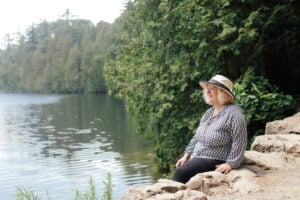In 1998, former U.S. vice-president Al Gore gave a speech titled “The Digital Earth,” rhapsodizing about the future of geo-spatial information. Within years, he predicted, it would lead to profound changes in how we understand the world around us.
To illustrate his point, he imagined a young girl going to a local museum. She dons a head-mounted display and is greeted by an image of the Earth from space. From there, she zooms in over continents, regions and cities. It’s a magic-carpet ride, and the girl is able to virtually explore global features — natural formations, political boundaries, human demographics, wildlife, histories and more — through data and information received on request.
Coming in the early years of the internet era, Gore’s vision was not difficult to imagine. Technologically, it was profoundly ambitious. The single largest challenge? Developing the tools to manage and integrate geo-spatial data with other information streams to harness its power.
Now, Calgary-based Pyxis Innovation is launching a new software package that takes a major step toward realizing Gore’s futuristic vision. Known as WorldView, it’s capable of integrating multiple streams of geospatial data — easily and in real-time — to create 3D maps for analyzing issues and answering questions. Perry Peterson, president and CEO of Pyxis, describes it as the first tool to bring the concept of digital earth to fruition.
“We’ve come a long way since the late 1990s. We have digital globes, like Google Earth. We have a lot pre-integrated data where we’re anticipating the questions,” Petersen says. “But in the purest form of the vision of digital earth, any form of the [core] geospatial questions — where is it, and what is here — can be answered on the fly. That requires sophisticated changes to the way geo-spatial data is produced and delivered to end users.”
For Peterson, WorldView achieves that change.
Ten years in the making, WorldView is scheduled to launch in the spring. At the heart of the software is a different concept of how maps are produced, known as a “digital earth reference model.” Unlike traditional mapping, a digital earth reference model — also known as a “discrete global grid system” — does not rely solely on presenting map points as intersections of latitude and longitude. Instead, it develops maps based on “cells,” with each cell capable of holding and displaying data.
Think of it as something like a super-charged spreadsheet where the interface is a 3D map, instead of a two-dimensional sheet of rows of columns that can instantly integrate data from various sources and display the results visually.
Now, think of a question. Suppose you want to look at moose distribution in Alberta. You’d start with a map of the province and stream in tracking data on moose. Concerned about run-ins with vehicles? Drop in data on highway routes, and you’ll see where moose populations and roadways intersect. Add data on wildlife-vehicle collisions and you’ll have a powerful representation of important issues in wildlife management and road safety.
Likewise, you could easily combine data to, say, track correlations between house prices and crime rates in a given area. The results could be useful in understanding the social impacts of rising or falling affluence. Similarly, you could investigate the consumption patterns for goods and services based on the location of factories or other economic investments, providing useful information for business planning. The more data you add, the more detail you see, focusing questions and pointing toward potential solutions on issues decision-makers face in all walks of life.
Indeed, WorldView’s applications are myriad and relevant in multiple sectors, ranging from policy and research to business and industry. And it’s no accident the innovation was born in Canada, specifically in Alberta. With the importance of resources to the national economy, Canada is already a world-leader in geomatic information technology says Mohamed Abousalem, CEO of Tecterra Inc., a Calgary-based geomatics technology commercialization agency funded by the provincial and federal governments. And Alberta is the centre of much of that activity. “Canada enjoys 20 per cent of the geomatics market worldwide,” Abousalem notes. “Alberta enjoys about 40 per cent of the Canadian geomatics market activity.”
That expertise has led to a special application for WorldView. With financial support from Tecterra, Lynn Moorman, an assistant professor of earth sciences at Calgary’s Mount Royal University, is collaborating with Pyxis to develop a version of the software specifically for classroom use, especially at the elementary levels.
“We’ve been building the whole interface from scratch, informed by pedagogy and research,” says Moorman, who is also a member of the Canadian Geographic Education national executive. “We [want] something that has a nice easy flow… Here’s some information I want. I can visualize that on this technology. Then I can ask a question. That’s the power of it.”
Better yet, WorldView goes beyond the basic goal of teaching geography, Moorman notes. It also shows students the power of geo-spatial information and the role it can play in problem solving.
That value is currently being explored in WorldView beta testing with students at Calgary’s Connect Charter School. The software is proving to be a hit. “The kids are having a blast with it in the classroom,” says Margaret Leland, a teacher at Connect who has been working with Moorman. “Some of the kids were relating it to the question, what if the world was a village. If it were a village of 100 people, what would it be in terms of different aspects. You can do that.”
Greg Neil, who teaches math and science at Connect, adds that WorldView is especially well-suited to the “inquiry-based learning” approach to education, employed at the school. As a teaching method, inquiry-based learning centres on giving students questions and providing tools with which to explore answers. You can look at a textbook, for example, and see an image of the world’s tectonic plates. The text can tell you that earthquakes occur along the boundaries of the plates. “But with a tool that allows you to add a layer that shows the plates, then add a layer that shows earthquakes and earthquake magnitude, students can now see that for themselves,” Neil says.
In addition to helping students explore specific ideas, WorldView also throws a fresh light on the value of geographical and geomatic information for problem solving in many areas. That was one of the features that motivated Tecterra to support Moorman’s work. “Science and technology will continue to be a primary tier in building our economy in the years and decades to come,” Abousalem says. “There is an eventual economic value to growing scientific aptitude in students early on in their school years.”
In the nearer term, WorldView is also earning kudos from educators as a tool for engaging students with the concept of geomatics and discovering its value. Says Moorman: “It gets the students thinking about being enablers of a solution.”




